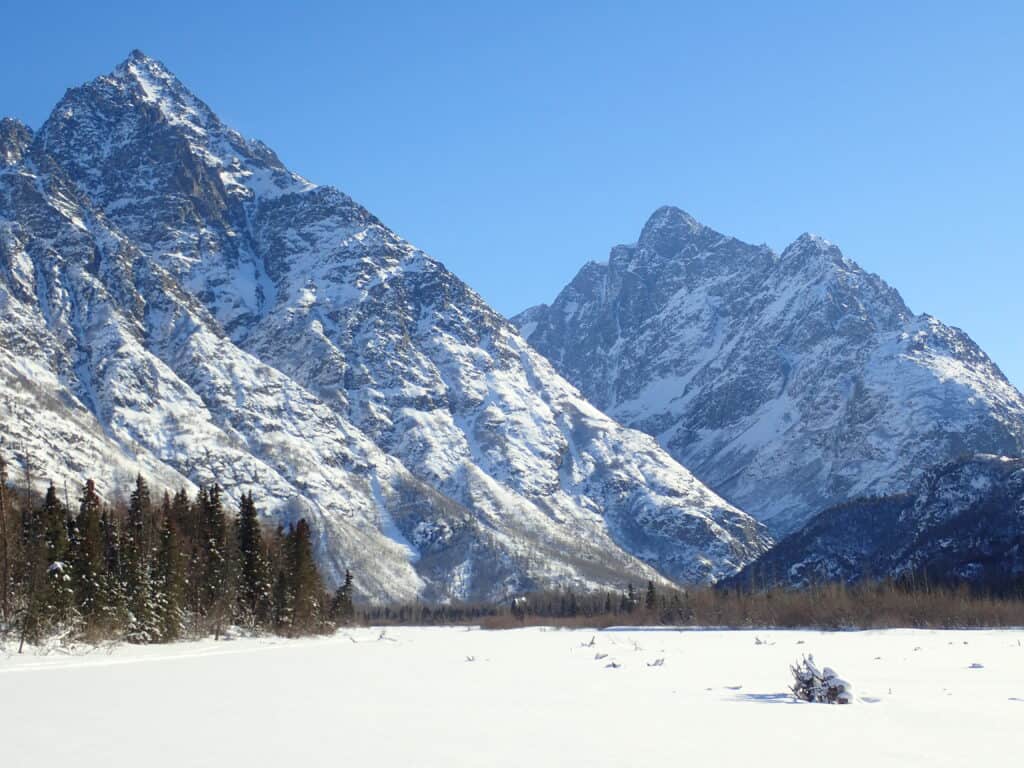Eagle River Valley. Southcentral Alaska.
The river is ours. We are the only humans traveling this brilliant white highway on a clear March morning. Our voices and the hollow crunch of heavy boots are the only sounds we hear. At this time of year we gain five minutes of daylight a day. Now that the sun has crested the mountains, it casts enough heat to penetrate our layers of wool and down and nylon. Ahh. We thaw out. We are bears waking up after a winter’s sleep.
“You’re crazy,” my daughter texted me before we left town this morning. The temperature at her house was -10 degrees.
“You’re right,” I replied.
I too doubted my judgment. Why would I willingly leave a cozy house, plenty of coffee, computer, TV, and books to head out into the frigid weather? But, the trip had been planned for months and my husband and I had plenty of clothes and food and friends waiting to join us. Of course we would go. So four of us, old friends since our children were small (and now have their own children), stuffed backpacks, loaded sleds, and hauled our gear to spend two nights camped in yurt along Eagle River. Just what we needed: an escape from the city, the internet, politics, and a constant bombardment of bad news. And, a chance to celebrate surviving another winter.
Though we’ve hiked this valley countless times in the summer, we revel in the ease of winter travel upstream. No scrambling up and over glacial rocks, slogging through the silty riverbank muck, or yelling “hey bear,” through the chest-high grass and cow parsnips along the trail. In an hour we’ve covered twice the distance we could reach by the same length of time in summer.
Still, we’re in no hurry. We dawdle to take pictures and puzzle over tracks: a canine—wolf, dog?—a moose, unmistakable with its long legs poking deep holes in the snow, a snowshoe hare leaving pellets along the shore where it nibbled on willows, and just below a clump of alders on the bank, tiny scratches left by a flock of red polls snatching seeds from the cones. A smooth narrow trail snakes through the snow and disappears into a plate sized hole in the ice. River otter, we decide, slipping beneath our feet. Further, behind a gentle snowdrift, we find a yawning crevasse, black water coursing deep below our apparently hollow surface: A warning to tread carefully.
The sun, the air, the crisp contrast of blue sky against white mountains, and the company of friends who share the wonder of it all, fills me with a peace I haven’t felt in months.
An overflow forms a silky gray pond of new ice as smooth as a hockey rink. We creep across, testing the strength of the ice, snapping pictures of bubbles, twigs, and leaves trapped just below the surface. Before long we’ve spent three hours meandering. Though daylight will linger for several more hours, the sun dips behind the mountain, and without it, the temperature will plunge below zero. We turn around reluctantly, thoughts of hot food, warm fire, and the comfort of our round little shelter, luring us back.
That night while the others sleep, I creep outside to check for the aurora. No blue or green streaks in the sky, just the glow of moonlight, so bright I see clearly without my headlamp: the white ribbon of river below us, the shadows of trees on snow. I breathe in the icy air, tuck my hands under my arms, and say a prayer of thanks for the beauty around me. This is my spiritual antidote to the anger, hatred, and violence in the world around us. I think of a quote from Doug Peacock, in Terry Tempest Williams book, The Hour of the Land, “insulate yourself with friends and seek out wild places.”
I duck back into the yurt, snuggle into my sleeping bag, and fall asleep to the snores of people I love.

